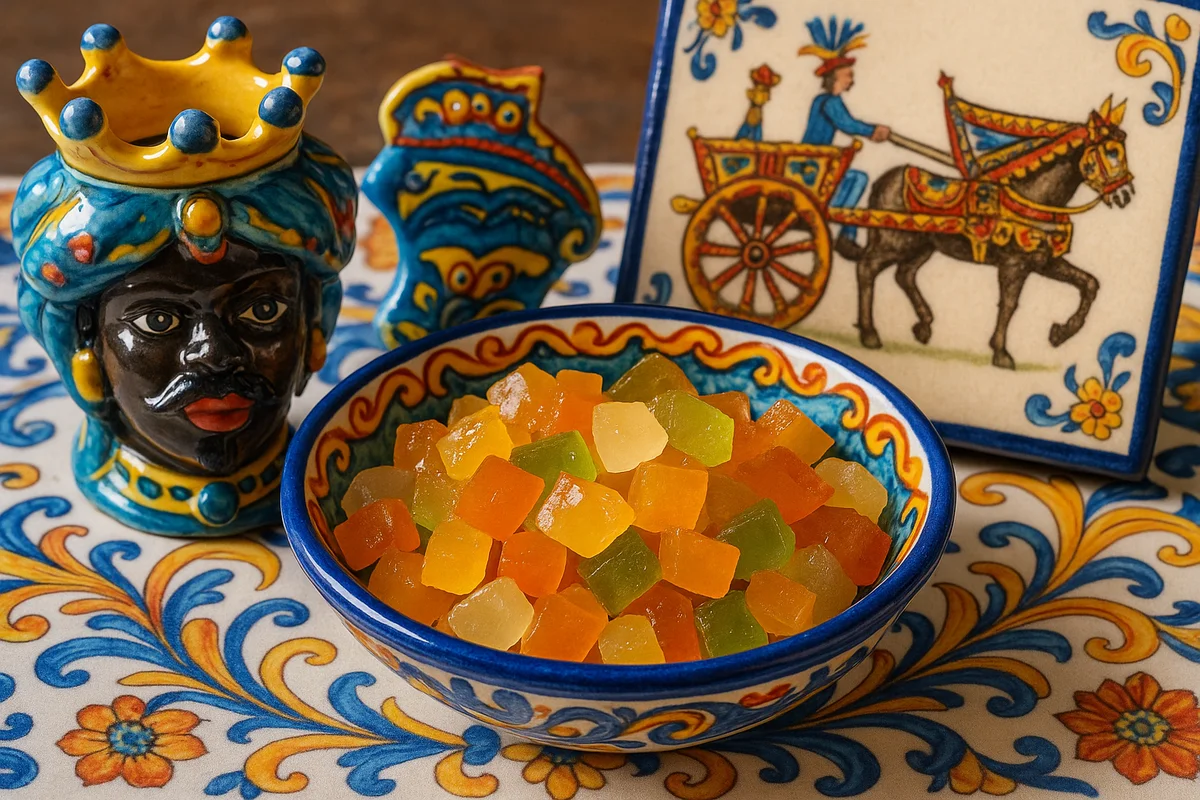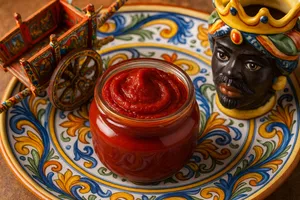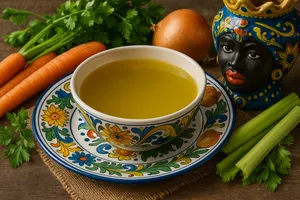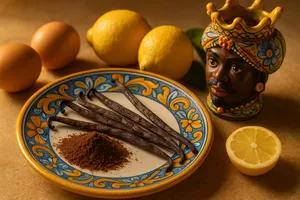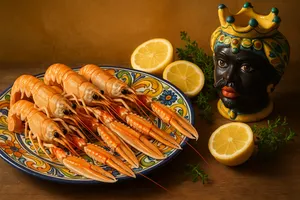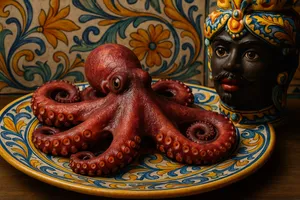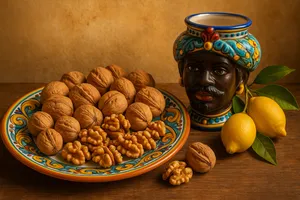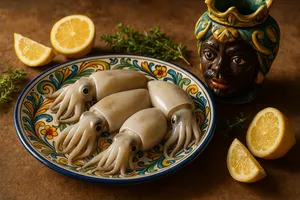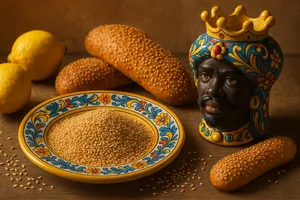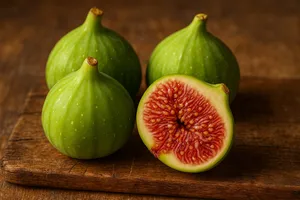Overview
Candied fruit, known in Sicilian as “cannila” or “frutta canniata”, consists of fruits or citrus peels preserved through a candying process that replaces the water in the pulp with sugar. This ancient preservation technique is especially cherished in Sicilian confectionery, where candied fruit plays a starring role in numerous creations, from the sumptuous cassata to cannoli, Christmas sweets, and Easter colombe.
The art of candying has deep roots in Sicily, where the island’s abundance of fine citrus fruits met the Arab tradition of preserving fruit in sugar. This encounter gave rise to products of exceptional quality. Sicilian candied fruit—particularly citron, orange, and lemon—is admired worldwide for its brilliance, colour, and aromatic intensity.
Characteristics
High-quality candied fruit appears translucent and glossy, with vibrant colours reflecting the original fruit: bright green for citron, deep orange for oranges, vivid yellow for lemons, and red for cherries. Its texture is soft yet not mushy, with a pleasant elasticity that allows it to be cut easily without crumbling.
The flavour is intensely sweet but should retain the distinctive notes of the original fruit: citrus aroma for citrus peels, fruity nuances for cherries or pineapple. Good candied fruit must not be so sweet as to obscure the fruit’s natural flavour.
The surface may be slightly tacky from residual syrup but should not be wet or rubbery. Artisanal candied fruit is often less uniform in appearance than industrial varieties, yet generally superior in taste and texture.
Types
Candied citrus peels
The most widely used in Sicilian confectionery are citron, orange, and lemon peels. Citron, with its thick and intensely fragrant pith, is considered the king of Sicilian candied fruit. Orange and lemon peels, thinner and more aromatic, offer a pleasing touch of bitterness to balance the sweetness.
Candied fruit
Cherries, sour cherries, apricots, pears, pineapple, and figs are candied whole or in pieces. Bright red candied cherries are among the most widely used in Sicily, especially for decorating cakes and cassate.
Candied marzipan fruit
A distinctly Sicilian speciality, these are marzipan fruits modelled and painted by hand, then lightly candied for a glossy finish. They are more works of art than mere ingredients.
Use in confectionery
In Sicilian pastry-making, candied fruit is an essential component of many iconic recipes.
Sicilian cassata
Candied fruit is fundamental to cassata: citron, orange, and pumpkin candied pieces are diced and mixed into sweetened ricotta for the filling, while candied cherries adorn the surface together with the green pistachio glaze.
Sicilian cannoli
The ricotta filling of cannoli is enriched with chocolate flakes and small cubes of candied fruit—usually orange and citron—which provide aromatic freshness and contrast with the creaminess of the filling.
Panettone and colombe
Though not originally Sicilian, these large leavened cakes are produced on the island using high-quality local candied fruit, especially diced citron and orange.
Buccellati and Christmas sweets
Traditional Sicilian buccellati, ring-shaped Christmas pastries filled with dried figs, nuts, and candied fruit, typically include finely chopped orange and citron. Cucciddati—Christmas biscuits—also contain candied fruit in their filling.
Ice creams and granitas
Cassata ice cream includes chopped candied fruit, and some artisanal ice creams use candied citrus peels to scent their base.
Artisanal production
Artisanal candying is a lengthy process requiring several days. Fruits or peels are first blanched to soften them and remove bitterness, then immersed in sugar syrups of gradually increasing concentration. Each day, the syrup concentration is raised, allowing the fruit to absorb the sugar slowly without becoming tough.
The process may last from 7 to 15 days depending on the fruit type and size. When complete, the candied fruit is drained and left to dry, then glazed with a very concentrated syrup for shine. Some varieties are finally rolled in crystal sugar for a crunchy finish.
Storage
Candied fruit keeps for a long time thanks to its high sugar content, which prevents bacterial growth. It should be stored in airtight containers, away from heat and direct light, in a cool, dry place.
Vacuum-packed candied fruit lasts many months, even over a year. Once opened, it should be transferred to tightly sealed glass jars and consumed within 2–3 months. When properly stored, it rarely deteriorates; at most, it may crystallise slightly or become firmer.
Avoid storing candied fruit in the refrigerator, as humidity makes it soft and sticky. If it becomes too hard, it can be softened by gently dabbing it with a cloth moistened with water or liqueur.
Buying tips
When purchasing candied fruit, it is preferable to choose artisanal products or those from specialised producers rather than low-quality industrial ones. Colours should appear natural—not overly bright or fluorescent, which would indicate artificial dyes.
Sicilian candied citrus, especially citron, is among the finest in the world. Always check the product’s origin on the label. Candied fruit should be soft and flexible, not hard or dry.
For baking, it is best to buy candied fruit already in pieces or cubes, rather than whole pieces that would require cutting. Organic or traditionally grown candied fruit is preferable, being free from artificial preservatives and colourings.
Homemade preparation
Candied fruit can be made at home, especially with citrus peels. The peels are cut, removing the white inner pith, then boiled in water—changing it several times—to eliminate bitterness. They are then immersed in a sugar syrup made with equal parts water and sugar.
Each day, the syrup is drained, brought to the boil with added sugar, and the peels are immersed again. After 5–7 days, the peels will be fully candied. They are then drained, dried on a rack, and stored in glass containers. Though time-consuming, the result is incomparable with industrial products.
Nutritional properties
Candied fruit is highly caloric due to its high sugar content: 100 grams provide about 300–350 calories, almost entirely from sugars (around 80–85 grams per 100 grams).
It contains very little fat or protein, while most vitamins originally present in the fruit—especially heat-sensitive vitamin C—are lost during candying.
It retains some fibre and minerals. Candied fruit should be consumed in moderation, particularly by those who need to monitor sugar intake. In traditional Sicilian pastry-making, it is used sparingly as a flavouring rather than as a main ingredient.
Curiosities
The art of candying in Sicily was introduced by the Arabs during their rule of the island (9th–11th centuries). Masters of fruit preservation using sugar and honey, they inspired the techniques later perfected by the pastry artisans of Sicilian convents.
In Palermo’s Kalsa district, a guild of “cannilari”—artisans specialised in candying—existed as early as the Middle Ages. Their skills were passed down through generations, and their products were exported across Europe, prized by royal courts.
Sicilian candied citron, especially from Palermo and Messina, was so esteemed that in the 18th century it was given as a precious gift to European rulers. Its quality owed much to Sicily’s microclimate, ideal for growing exceptionally fragrant citrons.
A Sicilian saying goes: “Cu' havi cannila 'ncasa, havi Natali tuttu l'annu” (“Whoever has candied fruit at home has Christmas all year round”), highlighting its association with festivities, abundance, and celebration.
In Baroque Palermo, the nuns of the convents created elaborate artistic candied pieces—fruits, flowers, even religious scenes—offered to benefactors or sold to support their community. These creations were true edible artworks, centuries ahead of modern pastry artistry.

